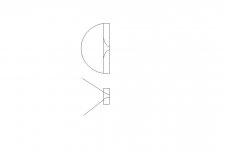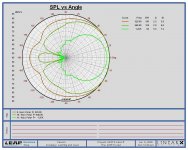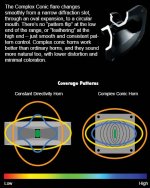It tells a lot about sound balance and actual loudness in a way that supplements SPL curves alone, but it does not fully tell how revealing a driver may be.gedlee said:
...
CSD is way overblown in terms of its telling us anything about audibility, and I don't see where a ribbon on a horn has any better CSD that a compression driver. You'd have to have some real data to back up your claims as they just aren't consistant with my experince in either measurements or sound quality.
...
soongsc said:
It tells a lot about sound balance and actual loudness in a way that supplements SPL curves alone, but it does not fully tell how revealing a driver may be.
I don't ignore it, but there is a lot more to a good system than just its CSD at a point.
Ribbons can go pretty high in frequency, and that's what normally gives them an advantage. However, depending on the design, most do ring quite a bit. Perhaps you can enlight us on some of your preferred ones with some CSD and impulse charts?RyanC said:Hey Patrick
...
I don't understand why some people here were so insistent on attempting to use a dome tweet, that offers no benefits and only drawbacks when compared to a compression driver (especially in a WG). But a ribbon is a different animal. Going 2+ octaves lower and having a near ideal CSD are both significant advantages, that I believe when properly dealt with in a WG have the potential to perform at a very high level. (I need to experiment more with tests though)
From what I understand, a compression driver is a dome, that has a compression chamber and a phase plug, no? My feeling, and analysis of CSDs and listening experience, is that ribbons (especially like the B&G ones) are simply a better transducer then a dome/voice coil. Furthermore I find the concept of a high functioning compression chamber/phase plug, to be made in low weights to be very problematic (sound is a bit more persistent than a couple small pieces of plastic). Not that they don't do what they are suppose to do to some extent, just that they have their issues as much as anything else does.
...
Totally agree.gedlee said:
I don't ignore it, but there is a lot more to a good system than just its CSD at a point.
JoshK said:I've heard and owned many speakers with ribbon tweeters. None of them have anything on Dr. Geddes' Summas IMO and I have heard the Summas.
Can you say more on your sonic impressions? Thanks.
Sorry I should have been more specific, the ones I'm mainly interested in are the B&G neo 8's and the stage accompany, although SA does not go lower than a 1" exit compression driver. Neither is really a ribbon in the true sense.
I'll definitely agree that the CSD is not the only or most important measurement, but if you take a look at the neo8's you can see that it does say something about the driver;
http://www.partsexpress.com/pdf/264-712s.pdf
The FR plot looks scary, especially WRT the off axis response, but the spike is easily dealt with, and the LF gradual fall of is where I am interested in using the loading to increase output. Then using acoustic foam on the insides of the horn/WG to minimize issues with HF bouncing, and to match their directionality (via absorption, not via wave guiding) in directly radiating HF to the the directionality of the loading at lower frequencies (within a few degrees). It appears the driver was measured on an OB, so it's a bit tough to say what the off axis will be in a IB. This is one thing I plan on measuring before I try the next setup. The line source behavior seems to come in to play nicely by increasing the output at 20k at typical listening distances.
I'm doing an active setup by the way.
The sensitivity is ~93 dB per driver, so 4 in a vertical line assuming good coupling (flanges need to be cut or overlapped) and you are looking at ~105 dB. . . which is not very different from the B&C 250 driver + foam plug 108-3, no?
I'm experimenting with foam on the sides now and it sounds like it's working but I need to tweak the thickness of it a bit, what I have now is too thick, standardard desnity acoustic eggshell type foam. I also intend to compare having no foam on the inside of the vertical walls. . .ah if only I didn't have to sleep.
I may be pursuing a dead end here, but I'm learning a lot, and just might stumble into something.
I'll read that paper Earl, thanks so much-
Ryan
I'll definitely agree that the CSD is not the only or most important measurement, but if you take a look at the neo8's you can see that it does say something about the driver;
http://www.partsexpress.com/pdf/264-712s.pdf
The FR plot looks scary, especially WRT the off axis response, but the spike is easily dealt with, and the LF gradual fall of is where I am interested in using the loading to increase output. Then using acoustic foam on the insides of the horn/WG to minimize issues with HF bouncing, and to match their directionality (via absorption, not via wave guiding) in directly radiating HF to the the directionality of the loading at lower frequencies (within a few degrees). It appears the driver was measured on an OB, so it's a bit tough to say what the off axis will be in a IB. This is one thing I plan on measuring before I try the next setup. The line source behavior seems to come in to play nicely by increasing the output at 20k at typical listening distances.
I'm doing an active setup by the way.
The sensitivity is ~93 dB per driver, so 4 in a vertical line assuming good coupling (flanges need to be cut or overlapped) and you are looking at ~105 dB. . . which is not very different from the B&C 250 driver + foam plug 108-3, no?
I'm experimenting with foam on the sides now and it sounds like it's working but I need to tweak the thickness of it a bit, what I have now is too thick, standardard desnity acoustic eggshell type foam. I also intend to compare having no foam on the inside of the vertical walls. . .ah if only I didn't have to sleep.
I may be pursuing a dead end here, but I'm learning a lot, and just might stumble into something.
I'll read that paper Earl, thanks so much-
Ryan
RyanC said:I'll definitely agree that the CSD is not the only or most important measurement, but if you take a look at the neo8's you can see that it does say something about the driver;
http://www.partsexpress.com/pdf/264-712s.pdf
That response is not on a horn. The CSD of a compression driver on a plane wave tube would look at least as good as that shown. probably a lot better. Its the typical low quality horns that give compression drivers a bad name. The drivers themselves are quite good when properly terminated with a good waveguide.
You started out questioning compression drivers as a good choice, but I am still contending that they are the best choice.
The reason the response looks so lousy for the Neo8 is that it is running dipole and unbaffled....much like running a compression driver in free air without a horn and measuring it. Though the BG drivers are nice and very affordable, I don't think you can find the kind of dynamics in planars that you can find in properly loaded compression drivers. Though the new Beyma Heil variant and associated horn are interesting, I don't think the uniform directivity of Earl's designs will be possible with it. In fact, I can't think of a single loudspeaker measured that I have seen that is as uniform as the Summa.
Chris
http://profesional.beyma.com/newsletterMarzo2008/TDTPL preliminary.pdf
Chris
http://profesional.beyma.com/newsletterMarzo2008/TDTPL preliminary.pdf
Hey Chris-
I don't have much experience here, but I gather that you cannot find good dynamics out of a raw compression driver either. The loading being the primary factor for increased perception of dynamics. My current prototypes have lots of problems, but dynamics isn't one of them.
Dr. Geddes, sorry I should have said something more like; I think that the neo8 is better for the design compromises that I wish to focus on and those that I wish to aviod. Sometimes my fingers are going faster than my brain is. I'm experimenting with foam on the outside walls of the horn and this seems to lower the effective loading considerably. I'm gettting significant levels below 200hz, with just the 2 drivers, in a 12" deep conical.
With a deeper horn or wg, and more drivers per side this should be able to extend all the way down to the non-directional LF.
One thing that I notice, and I don't intend this to be a condemnation of your design Dr. Geddes, just an observation is that while the WG has excelent CD characteristics, mating it to a rather beamy 15" at 1k would clearly not be constant with reguard to the speakers overall directivity right? Speakers are a balance of compromise, and I would surmise that if there was an easy way for the WG to go an octave lower, you would be pursue that, if it could fit the rest of your design? I'm suggesting that the load neo8s are . . .
For me, I'm interested in going 3 octaves lower with a 2 way, loosing a little bit of the directivity control, in favor of designing the speakers for a specific room, and a chosen coverage area. For this the area is sitting to standing, and on the centerline front to back. If the drivers are loaded to provide the extension and dynamics, and foam is used to absorb defractions above the loading freq, the directivity will of course not be constant. But it will be consistant through the designated coverage area, while also allowing very little energy to create wall reflections inside the 20ms window.
At least that is the concept that I'm operating on, and so far so good. . .I just need to order some more Neo8s and do some serious testing.
Thanks again guys-
I don't have much experience here, but I gather that you cannot find good dynamics out of a raw compression driver either. The loading being the primary factor for increased perception of dynamics. My current prototypes have lots of problems, but dynamics isn't one of them.
Dr. Geddes, sorry I should have said something more like; I think that the neo8 is better for the design compromises that I wish to focus on and those that I wish to aviod. Sometimes my fingers are going faster than my brain is. I'm experimenting with foam on the outside walls of the horn and this seems to lower the effective loading considerably. I'm gettting significant levels below 200hz, with just the 2 drivers, in a 12" deep conical.
With a deeper horn or wg, and more drivers per side this should be able to extend all the way down to the non-directional LF.
One thing that I notice, and I don't intend this to be a condemnation of your design Dr. Geddes, just an observation is that while the WG has excelent CD characteristics, mating it to a rather beamy 15" at 1k would clearly not be constant with reguard to the speakers overall directivity right? Speakers are a balance of compromise, and I would surmise that if there was an easy way for the WG to go an octave lower, you would be pursue that, if it could fit the rest of your design? I'm suggesting that the load neo8s are . . .
For me, I'm interested in going 3 octaves lower with a 2 way, loosing a little bit of the directivity control, in favor of designing the speakers for a specific room, and a chosen coverage area. For this the area is sitting to standing, and on the centerline front to back. If the drivers are loaded to provide the extension and dynamics, and foam is used to absorb defractions above the loading freq, the directivity will of course not be constant. But it will be consistant through the designated coverage area, while also allowing very little energy to create wall reflections inside the 20ms window.
At least that is the concept that I'm operating on, and so far so good. . .I just need to order some more Neo8s and do some serious testing.
Thanks again guys-
What is the CD beamwidth, then, what is the woofer beamwidth at the desired crossovr frequency?
You push it lower if the 15" doesn't play well up there.
What's the 15" beamwidth two octaves lower?
There's some point or purpose to doing a 180° CD waveguide?
You push it lower if the 15" doesn't play well up there.
What's the 15" beamwidth two octaves lower?
There's some point or purpose to doing a 180° CD waveguide?
RyanC said:
One thing that I notice, and I don't intend this to be a condemnation of your design Dr. Geddes, just an observation is that while the WG has excelent CD characteristics, mating it to a rather beamy 15" at 1k would clearly not be constant with reguard to the speakers overall directivity right?
No, this is incorrect. You sould look at the polars on www.Ai-audio.com. The waveguide and the 15" have the same directvitity at about 1 kHz. Your own data shows that. And if you read my white paper you will see why I don't attempt to go lower with the directivity control. It can be done, but the tradeoffs are not good ones. The ideal appears at this point to be a 15" waveguide and a 12" woofer as they mate better than any other combination.
tinitus said:Is this a waveguide ?
Its too hard for me to tell from a sketch. It looks corret, but I can't be sure.
Thanks, Rob.Robh3606 said:Hello Zilchlabs
Here's what a 15" 2235 looks like in typical reflex box.
Rob🙂
Seems like JBL knew what they were doing with that woofer in 4430.
At 320 Hz, it'd take a ~160° CD horn or waveguide to match up.
While I can conceive of applications where that might be appropriate, normal listening environments would not be among them....
I read Horn VS waveguide with a great interest.
May I ask you can the Renkus-Heinz complex conic topology be compared with waveguides, or it is still have listed horn drawbacks?
May I ask you can the Renkus-Heinz complex conic topology be compared with waveguides, or it is still have listed horn drawbacks?
15" waveguide and 12" woofer, or 15"+15"?gedlee said:
No, this is incorrect. You sould look at the polars on www.Ai-audio.com. The waveguide and the 15" have the same directvitity at about 1 kHz. Your own data shows that. And if you read my white paper you will see why I don't attempt to go lower with the directivity control. It can be done, but the tradeoffs are not good ones. The ideal appears at this point to be a 15" waveguide and a 12" woofer as they mate better than any other combination.
454Casull said:
15" waveguide and 12" woofer, or 15"+15"?
That depends on what frequency that you are talking about. The waveguide is basically constant in directivity and both the piston sources have narrowing directivity with frequency, hence they both equal the waveguide at some frequency, just not the same one.
dimitri said:I read Horn VS waveguide with a great interest.
May I ask you can the Renkus-Heinz complex conic topology be compared with waveguides, or it is still have listed horn drawbacks?
You'd have to show a picture or a drawing. I don't keep up on every manufacturers lastest wizbang - its a "contour of the month" club.
Renkus-Heinz complex conic topology
here it is,
thank you
You'd have to show a picture or a drawing.
here it is,
thank you
Attachments
- Home
- Loudspeakers
- Multi-Way
- Geddes on Waveguides


